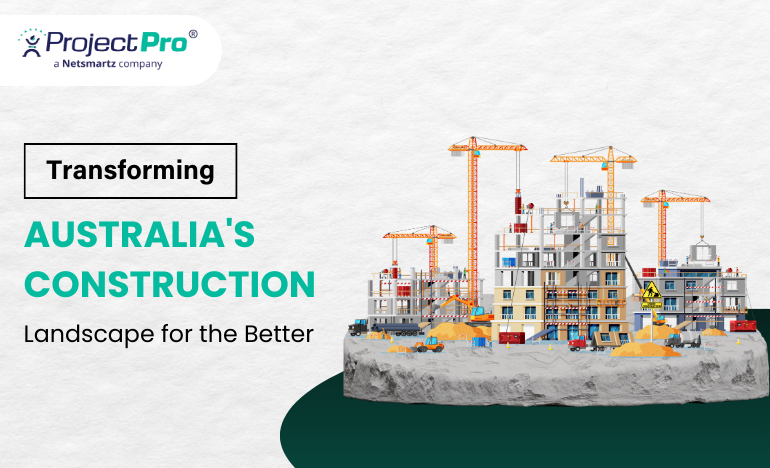How Technology Can Revolutionize Construction Productivity of Australia

Australia's construction industry is a vital pillar of its economy, contributing significantly to GDP growth and employment. However, it has long been criticized for its low productivity levels compared to global standards.
As the demand for infrastructure and housing projects surges, the need to enhance construction productivity becomes more pressing. The solution? Embracing cutting-edge technologies that can revolutionize how projects are planned, executed, and monitored.
This article explores how technology can breathe new life into Australia's construction sector and pave the way for a more efficient and prosperous industry.
Challenges in the Australian Construction Industry
Before delving into the transformative power of technology, it's crucial to understand the challenges that have plagued the Australian construction industry for years. Some of the most pressing issues include:
Low Productivity: Historically, Australia has struggled to match the construction productivity levels of its international counterparts. This can be attributed to various factors, such as outdated work practices, inefficiencies in project management, and a lack of innovation.
Cost Overruns and Delays: Many construction projects in Australia suffer from cost overruns and delays, leading to budgetary constraints and diminished stakeholder confidence.
Safety Concerns: Ensuring the safety of construction workers is paramount, but the industry still faces significant safety challenges. Implementing advanced safety measures is essential to protect workers and reduce accidents.
Complexity and Fragmentation: Construction projects involve numerous stakeholders, including architects, contractors, engineers, and regulatory bodies. Efficient communication and collaboration are often hindered due to the complexity and fragmentation of these teams.
Environmental Impact: With growing concerns about climate change, there is a need to adopt more sustainable construction practices to minimize the industry's environmental footprint.
Technological Innovations Driving Change
As per a report by McKinsey, adopting construction management software can lead to a 20% reduction in project delays and a 15% reduction in project costs.
Construction Accounting and Project-based Software: Construction-specialized software platforms like ProjectPro facilitate project planning, scheduling, and resource allocation. They offer real-time visibility into project timelines, helping teams identify bottlenecks and make informed decisions promptly.
Building Information Modeling (BIM): BIM is a revolutionary technology that enables the creation of digital representations of a construction project. It enhances stakeholder collaboration by providing a central project data repository, reducing errors, and allowing real-time updates. BIM enables virtual simulations and clash detection, minimizing conflicts before construction begins.
Drones and Aerial Imaging: Drones equipped with cameras can capture aerial images of construction sites, providing project managers valuable insights into progress, site conditions, and potential issues. This data can aid in efficient resource allocation and site management.
IoT and Sensors: The Internet of Things (IoT) allows for integrating sensors into construction equipment and materials. This enables real-time monitoring of equipment health, worker safety, and environmental conditions.
Robotics and Automation: Robots can handle repetitive and labor-intensive tasks, freeing human workers for more skilled activities. This leads to increased efficiency and reduced construction time.
Augmented Reality (AR) and Virtual Reality (VR): AR and VR technologies enable immersive project visualization, aiding in design reviews, stakeholder communication, and worker training.
Benefits and Future Prospects
Embracing these technological advancements can benefit Australia's construction industry:
Enhanced Productivity: By streamlining processes, reducing errors, and optimizing resource allocation, technology can significantly boost productivity levels.
Cost Savings: Efficient project management and reduced delays result in cost savings, benefiting construction companies and clients.
Improved Safety: IoT-enabled sensors and real-time monitoring can enhance on-site safety, reducing accidents and improving worker well-being.
Sustainability: Technology facilitates the adoption of sustainable practices, including energy-efficient designs and the use of eco-friendly materials.
Better Stakeholder Collaboration: BIM and collaborative software platforms improve communication among project stakeholders, leading to smoother workflows and fewer misunderstandings.
Faster Project Completion: Automation and robotics accelerate construction timelines, enabling projects to be completed faster.
The road ahead involves further research and development of construction-specific technologies, fostering collaboration between technology providers and construction firms, and investing in workforce training to ensure seamless adoption of these innovations.
Summing Up
Since the Australian construction industry is in dire need of technology, as a Microsoft Partner, you can take advantage of this opportunity to dive into the construction vertical. You can partner with Microsoft ISV Partner – ProjectPro, a #1 construction accounting software solution provider powered by Dynamics Business Central, to give you an edge in the industry. Partner today!




.jpg)

